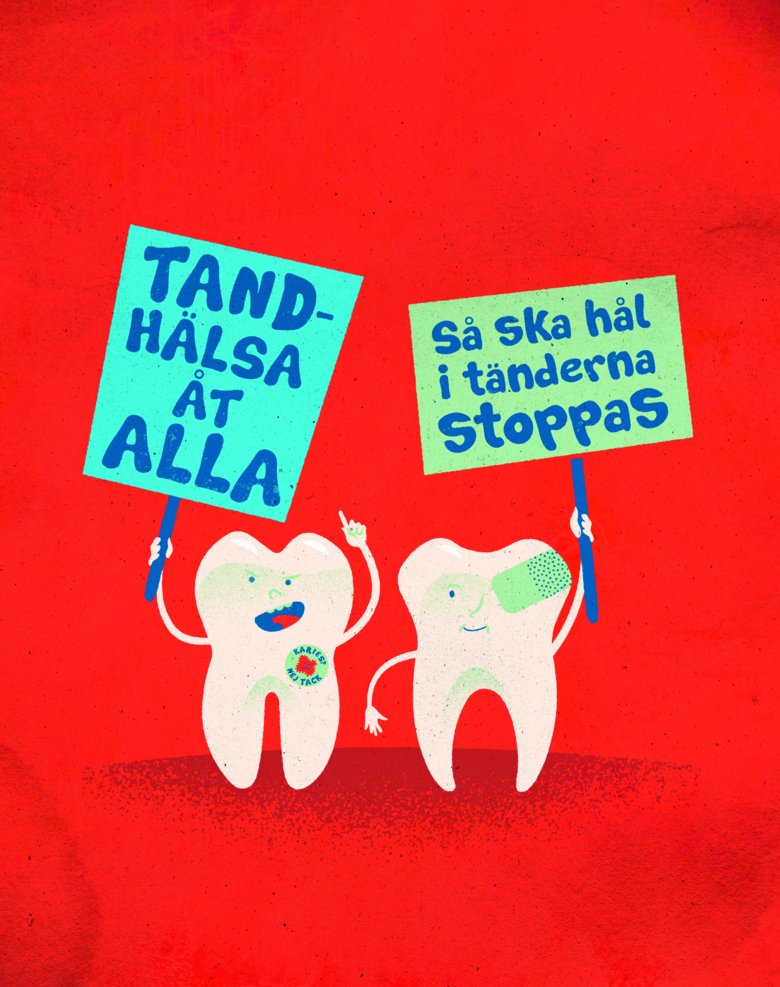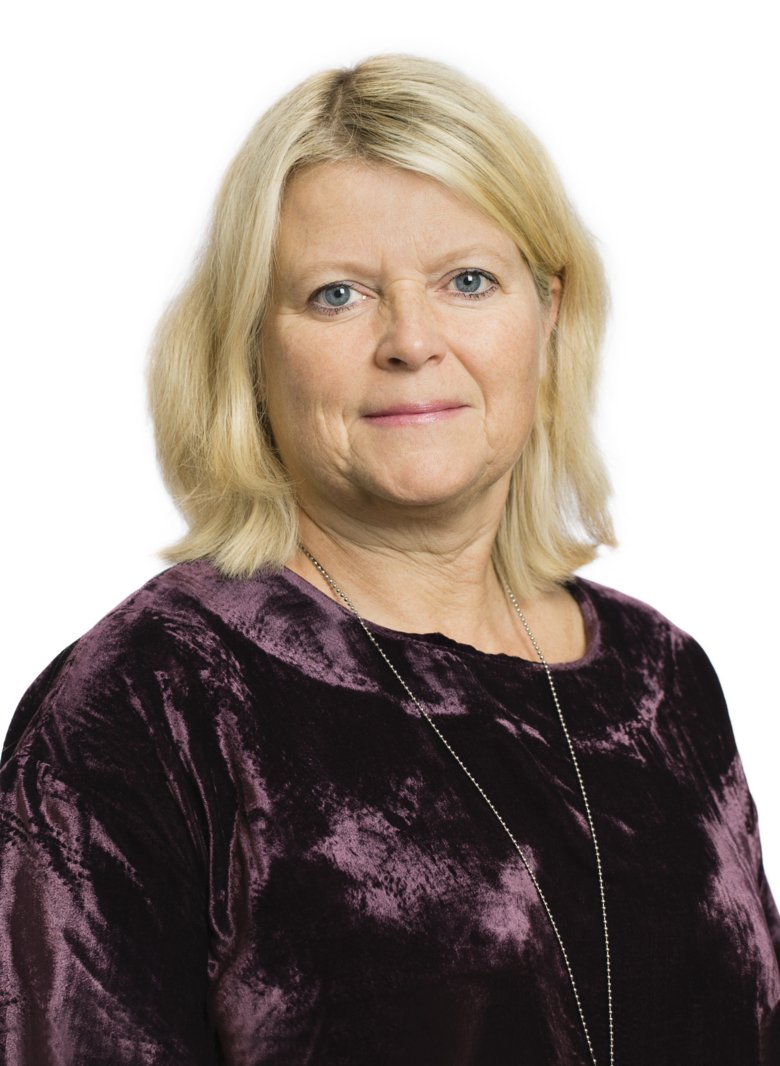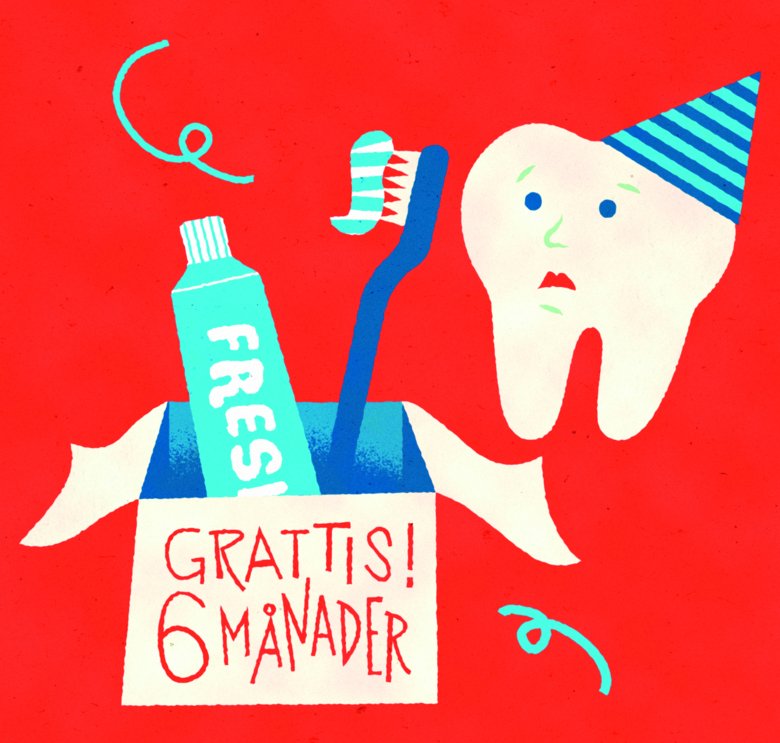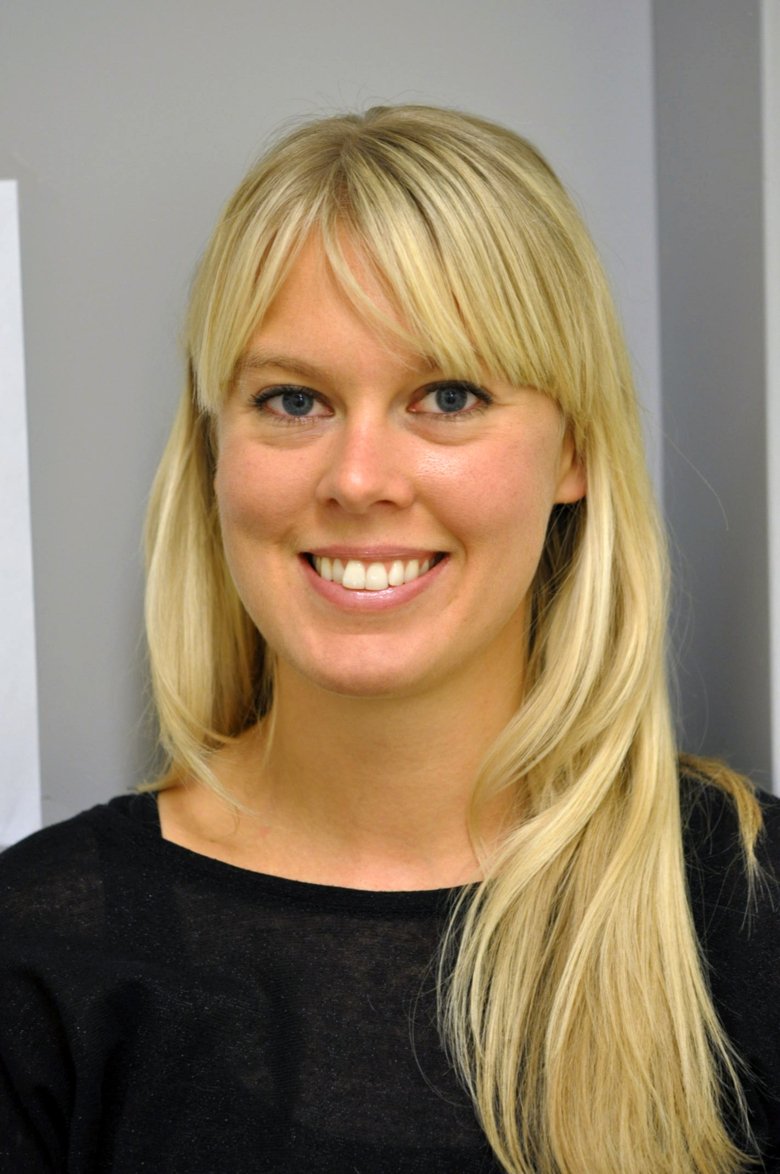Better dental health for everyone
Tooth decay affects those with a low level of income and education to a greater extent than other groups. Why that is, and what we can do about it, is the number one research question within the field of caries.

Text: Fredrik Hedlund, first published in Swedish in Medicinsk Vetenskap No 4/2019
Caries is the most common disease in the world. More than one third of the world’s grown up population, or 2.4 billion people, have untreated caries in their permanent teeth as we speak. Add to that an additional 600 million children with untreated caries in their baby teeth. That amounts to a total of three billion people worldwide with untreated caries. It might be hard to believe, but it is unfortunately true.
Research also shows that the proportion of the world’s population living with caries has remained unchanged since 1990, but that does not mean that there have been no developments.
“In high-income countries such as Sweden, the incidence of caries has decreased, but it has also increased in low and middle-income countries,” says Göran Dahllöf, senior dentist and Professor of Paediatric Dentistry at the Department of Dental Medicine, Karolinska Institutet.
Not a prioritised research area
But despite caries being the world’s most common disease, there are no patient associations, no celebrity spokespeople for the disease and no galas to support those suffering from caries. This is also something which has had consequences in the research field, where caries is often obscured by other more high-profile diagnoses.
“Although caries is a major global health issue with high societal costs, it is not a priority area when it comes to research funding. There are also no influential patient associations that can help shape public opinion or support research. But the mysteries of caries have yet to be solved,” says Göran Dahllöf.
However, it is not what causes caries that needs further study – the causes are already well-known.
“It’s bacteria and sugar,” says Annika Julihn, senior dentist at the Eastman Institute at Folktandvården in Stockholm, and researcher at the Department of Dental Medicine, Karolinska Institutet.
Instead, the factors affecting the bacterial flora and sugar intake are what is interesting from a research perspective. Annika Julihn calls them risk indicators rather than risk factors, as they do not directly cause caries.
“Having parents born outside of Sweden is, statistically, a risk indicator for caries. But that does not mean that you are more likely to get tooth decay just because you have a parent who was born abroad. Rather, caries can be caused by factors such as not having the same routines when it comes to diet and oral hygiene,” she says.

Researchers from around the world have identified more than 90 risk indicators, with some of the most important ones being related to socioeconomic conditions. These include a lack of education, low income and parents born abroad.
Sweden has one of the best paediatric dental services in the world, with free dental care until the age of 23. That means that if you are born abroad and make your way to Sweden, you have most likely experienced a worse system, which may explain poorer dental health. Children born in Sweden to foreign-born parents are also considered a group with poorer dental health. There is no simple explanation for this correlation. But according to Annika Julihn, there may be cultural elements which do have an impact.
“If you, for example, give you children tea with honey from an early age or breastfeed them for a significantly longer period of time, while also not being thorough when it comes to their oral hygiene, the risk of caries increases,” says Annika Julihn.
But an increased risk can also be attributed to a lack of time or knowledge about what causes caries. The routine of brushing your child’s teeth as soon as the baby teeth have visibly begun to appear and then continuing to brush their teeth as they grow up is not always something that is obvious. On the contrary, it is sometimes seen as something positive to let the children manage their own oral hygiene.
“Many parents think their children are very capable because they can brush their own teeth,” says Annika Julihn.
She explains that parents are often in complete shock when their children develop serious caries.
“Sometimes we have to remove ten teeth,” says Annika Julihn.
Older siblings have better dental health
One of the relatively new risk factors that Annika Julihn discovered is that the order in which siblings are born has a significant impact on the incidence of caries.
“What we see is that the oldest child has much better dental health than their siblings. Child number two has slightly worse and the third child has worse still, and then it continues to deteriorate for every additional child. It is probably not caused by anything more complicated than a lack of time. It is difficult for the parents. The younger siblings are also exposed to sweets at an earlier age since the older siblings are getting them at their age,” she says.
Many have realised that children’s dental care needs to start much earlier than their first dental visit. Annika Julihn agrees.
“Ideally, I’d like to see us involved as early as maternity care. We must have projects where we collaborate with healthcare services because it is not enough for us in dental care to just come and provide information,” she says.
In order to identify children who may risk developing caries as early as possible, she has looked for risk indicators in pregnant mothers. That is how the risk indicator regarding the order in which siblings are born was discovered.
“This has not been a priority in our preventive work, which we need to do much, much more of in child health centres. In families with more than one child, the younger children are at risk,” she says.
Other early risk indicators include young mothers, mothers who smoked during their pregnancy and mothers who are overweight and exhibit obesity. However, caesarean sections are not a risk indicator, which she originally thought would be.
“Children born through caesarean section did in fact have a reduced risk of contracting caries compared to those born vaginally,” she says.
This was surprising to the researchers, as they previously knew that the mother transfers much more of her good bacterial flora when giving birth to children vaginally and that the good bacterias can serve as protection against disease-causing bacterias. This is because caries is caused by an imbalanced oral bacterial flora, the so called oral microbiome.

“Caries is caused by a specific group of caries bacteria that we are all born with and which can rarely be removed entirely,” says Margaret Sällberg Chen, dentist and Associate Professor in Infection Biology at the Department of Dental Medicine, Karolinska Institutet.
The good and bad bacteria live in a kind of balance in the mouth, partly due to our genetics, but to an even greater degree, due to our diet.
“It is like in a society, as long as everyone gets along, there is not much trouble, but as soon as any group starts to take over, there may be problems. The caries bacteria consume sugar and secrete acid at a rapid rate, which makes the environment less beneficial for other bacteria. This is their way of establishing dominance in the microbiome. Since they are located on our teeth, the secreted acid also erodes the enamel of the tooth,” says Margaret Sällberg Chen.
Sugar allow the caries bacteria to grow stronger
In other words, caries could be described as a side-effect of the caries bacteria managing to expand their territory in the microbiome. And anyone putting sugar in their mouth feeds their caries bacteria, allowing them to grow stronger.
The antidote to sugar is called fluoride. Free fluoride ions from toothpaste and mouthwash enter the microbiome and affect both the composition and the function of the bacteria.
“Fluoride interacts with the metabolism of the sugar-consuming microorganisms. It both decreases the bacterial acid production and benefits the type of bacteria, which entails a lower risk of caries,” says Göran Dahllöf.
It is a very potent “sugar brake” and the main reason that caries has become less common in high-income countries such as Sweden over the past decades.
But despite this, both children and adults still suffer from caries in Sweden. It is not spread evenly across all of society though. The poor and less educated are the most affected, where caries takes root during childhood and then never letting go.
“There is hardly any disease with a stronger social gradient than caries. If your dental health was poor when you were a child, it will be poor when you are an adult. Because even if you have a successful career and get a well-paid job, your dental health will still be worse than others in comparable situations who have not made the social journey. Poor dental health takes root early,” says Göran Dahllöf.
Why dental health is so socioeconomically skewed, and what can be done about it, really is the big research question. Göran Dahllöf tells us of a Swedish study which examined the problems for parents who did not bring their children to their scheduled dentist appointments.
“The general problem was an excessive burden in their everyday lives. It could be unemployment or the stress of working multiple jobs, being a single parent or struggling with addiction. They do not have the energy to prioritise the children’s dental care, they do not even have the energy to call to cancel their appointment with the dentist,” he says.
An increasing number of researchers have begun to argue that our current dental care, which is oriented around reactively treating dental problems as they arise, will not be enough to solve the uneven socioeconomic distribution, either nationally or internationally. Last summer, the scientific journal The Lancet published a series of articles where international dental health was analysed. Those articles conclude that our current dental care is outdated and ineffective. And Göran Dahllöf is inclined to agree.

“The western care paradigm, with a high-tech, treatment-oriented individual perspective, is not adapted to the majority of the world’s population,” he says.
And despite high-income countries like Sweden having the best dental health in the world, he is of the opinion that our current dental care system only exacerbates the uneven socioeconomic distribution.
“If you employ a care perspective oriented around the individual and provide information on how to avoid caries, it is the most highly educated who will best absorb this information, which in turn makes the divide grow even bigger,” he says.
Successful marketing by the sugar industry
The interests and forces in play are too great to place the responsibility of combatting caries on single individuals, according to the researchers at The Lancet. As an example, they mention that the World Health Organization, WHO, as early as 2003 concluded that free sugar should be limited to 10 per cent of one’s daily energy intake, but this message then disappeared from WHO’s global strategy for diet, physical activity and health which was published the following year. According to the authors of the article, the reason for this was the successful lobbying of the global sugar industry. WHO would eventually present the recommendation, but only in 2015 – eleven years later.
The researchers also highlight how the global soda companies are increasingly targeting children and ethnic minorities in the United States with their marketing, as well as the growing economies in countries such as India and China. It is one of the major reason for caries becoming increasingly common in low and middle-income countries. Pepsi’s marketing budget for India for next year alone surpasses the entire annual budget of WHO, according to the researchers.
Even though Göran Dahllöf points out that caries in baby teeth, which in Sweden peaks before the age of four, is likely not caused by consuming too many sodas, he agrees with the researchers’ point that the power of the sugar industry is a problem and that the total sugar consumption must be reduced.
“I think we need to inform people that you should not give children food and drink with high sugar content before they turn two. This will give them the chance to develop a microflora that is more resistant to the sugar-consuming bacteria’s ability to take root later when the amount of sugar in their diet increases. But these ideas are counteracted by the baby food industry, which in some cases sell products containing a fairly high amount of sugar,” he says.
What is required are structural, population-oriented measures to reduce the sugar consumption among the general population. Göran Dahllöf points out that there are already 59 countries worldwide that have successfully introduced a sugar tax. In Europe, these include our neighbours Norway and Finland, but also France, Belgium, Portugal and the United Kingdom.
“Mexico is another good example, where they have managed to reduce both child obesity rates and the incidence of caries through significant price hikes on sugar,” he says.
But in Sweden, discussing a sugar tax is not even on the table, and the question is why?
“I think it’s because we do not feel that caries among children is a problem in Sweden. There is an uneven socioeconomic distribution, sure, but in general we have amazing dental care to deal with this issue, so it works,” says Göran Dahllöf.
But it is a problem. Swedish data shows that the incidence of caries among children and young people is more than five times higher in poor areas compared to rich ones. In order to counteract the uneven socioeconomic distribution when it comes to dental health, there are a number of ongoing research projects in Sweden aimed at finding ways to help those impacted the hardest. One of these research projects is called “Hälsovägledare i tandvården” (Dental Health Counsellors), and the method is taken from the health and medical care services.

“During the first part of the research project, our target group is preschoolers who must be treated under anaesthesia due to the severity of the caries. This is one area where our preventive efforts clearly fall short,” says Ida Brännemo, dental specialist in paediatric dentistry and doctoral student at the Department of Dental Medicine, Karolinska Institutet.
The idea is to help families prevent children from experiencing new caries lesions after the treatment. The health counsellors meet the family prior to the treatment to discuss oral health, what the family has done up to this point, and which strategies they should use to avoid caries in the future. The health counsellor then has regular phone contact with the family every other week or so for one year.
“The structure is based on a method used by the health and medical services during similar interventions. We will assess whether this structure also works in this scenario or if we need to change it. They will then reconvene after one year to look at the child’s dental health and discuss their family situation,” says Ida Brännemo.
An early start is key
The first study includes around 150 families, where half are aided by a health counsellor and the other half function as a control group. According to Ida Brännemo, the effect will be evaluated during follow-ups of the children’s caries development and quality of life after one and two years, with first results expected in the summer of 2020. This will be followed by a second study which will include children suffering from severe caries and who have yet to turn three. The study will likely start next year.
By focusing on preschoolers with serious caries-related problems, researchers will circle in on the children with major oral health issues. But since already established caries in a child is the strongest indicator that they risk getting even more caries, it would definitely be better to start at an earlier point, before the first caries lesion begins. Ida Brännemo tells us of a project known as the Rinkeby Project, where child health services along with the branch of social services focused on preventive efforts have tested an expanded home visitation programme in a vulnerable area. Instead of the standard single home visit following childbirth, around 100 families have received up to six visits.
“When the children are between six and eight months old, the parents have been given a toothbrush and fluoride toothpaste. They are then urged to start brushing when the first tooth emerges. We then compared these to a group of families who received the customary single visit. We can see that the families in the project brush their children’s teeth to a larger extent and that these children have less caries when they turn 1.5 years old,” says Ida Brännemo.
The home visit project is now being scaled up in a larger study, which will include 3,400 newborn babies in Stockholm. The project will run between 2020 and 2022 with evaluations in 2023 and 2024. The results will then determine whether the method should be deployed on a national scale.

Caries can be a red flag
However, problems with caries early in life can also be a symptom of other more serious problems in the family. In a study from 2018, Therese Kvist, researcher at the Department of Dental Medicine, Karolinska Institutet, observed a link between concerns of child abuse (neglect, violence between parents, physical or psychological abuse or sexual abuse) and a high incidence of caries, as well as irregular visits to the dentist. She found four factors which stood out as important indications: The first is that the child has had caries in their baby teeth, and the second is that the child has fillings in their permanent teeth.
The third is that the child has missed dentist appointments over long periods of time, and lastly that the child has been referred to a dental specialist. The likelihood that the child’s circumstances would be under investigation by social services for some form of child abuse was over 90 per cent if all four factors applied to the child in question.
“If a child has caries in both their baby teeth and permanent teeth and then gets referred to a specialist, you cannot automatically assume that this is a child who is being harmed. All four factors can apply to children who live in a functioning, happy family. But it is a clear warning signal indicating that we as dental care professionals need to investigate what is actually causing the repeated caries lesions,” says Therese Kvist.
She argues that it is most certainly part of dental care professionals’ assignment to investigate a child’s living conditions.
“Our goal is to stop caries, and as such we need to understand why the child has caries. In some cases, we will see families who are in need of help and support, and in some cases we will see children who are in need of protection,” says Therese Kvist.
She points out that it is part of a dentist’s statutory responsibility to file a notification of concern with social services if they suspect that a child is being harmed. She feels that her study has helped those working within the sphere of dental care to become more aware of children being harmed.
“There is now a greater awareness within dental care that these are issues we need to work with continuously and pay attention to. There is also increased awareness among other actors, such as social services and the police, who understand that dental care is an important piece of the puzzle when it comes to children’s living conditions,” she says.
Facts: How caries works
- A healthy and balanced diet creates a healthy balance in the oral bacterial flora. The enamel is demineralised and remineralised at a sustainable rate.
- Too much sugar often leads to the caries bacteria taking over. It creates an acidic environment where the enamel is demineralised faster than it is remineralised. This creates a cavity.
- If the cavity is not fixed and the sugar-rich diet continues, the cavity will grow larger and deeper. It will result in a toothache and can in the worst-case scenario damage the root, leading to the tooth being lost
How to keep the tooth decay at bay
- Keep track on your habits. Eat less sugar, no snacking, and brush your teeth with fluoride toothpaste.
- Chew sugar-free gum. Caries bacteria absorbs xylitol, but they cannot process it, which kills them. Gum also increases saliva flow, which helps keep the areas around your teeth clean.
- Ditch the sports drink. An increasing number of studies show that elite athletes are severely affected by caries. Constant sipping on a sports drink during practice and competitions continuously provides the bacteria around the teeth with sugar, causing caries.
- Snus can both protect and harm. Snus has a high pH value which is good for fighting caries as it attracts a different kind of bacteria. On the other hand, it causes bad breath and can also cause damage to your gums.
- Back in the good old days. Before sugar was introduced, caries was not as big of a problem. There are communities in other parts of the world where sugar is not a part of their culture. They never brush their teeth, but they also rarely suffer from caries.
